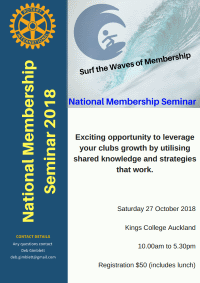Club Development for Rotarians
 Flexibility - an addition to the lexicon of Rotary. As part of Rotary's efforts in fostering change to adapt to the 21st century family, social and working environment of the current and future generations of Rotarians, Rotary Clubs now have two important opportunities - club flexibility around your club arrangements and the introduction of Satellite clubs.
Flexibility - an addition to the lexicon of Rotary. As part of Rotary's efforts in fostering change to adapt to the 21st century family, social and working environment of the current and future generations of Rotarians, Rotary Clubs now have two important opportunities - club flexibility around your club arrangements and the introduction of Satellite clubs.CLUB FLEXIBILITY
Research and our members' experiences have shown that when clubs have more freedom to decide how and when they hold their meetings, who they'll invite to become members, and what member engagement means, their ability to attract new members and keep current members motivated increases.
The 2016 Council on Legislation voted to give Rotary clubs more flexibility than they've ever had. The changes in policy affect when, where, and how clubs meet and the types of membership they offer.
5 WAYS TO USE THE NEW FLEXIBILITY
It's up to your club to decide how — and if — you want to use the new options. Start by reviewing the updated Standard Rotary Club Constitution to see which guidelines are flexible. Once you've decided what changes would benefit your club, edit your club bylaws to reflect them, and try them out. If you decide they aren't working, try something else. Here are some examples of how your club can apply the new flexible options:
- Change your meeting schedule. Your club can vary its meeting days, times, and frequency. For example, you could hold a traditional meeting on the first Tuesday of the month to discuss business and service projects and get together socially on the last Friday of the month. You just need to meet at least twice a month.
- Vary your meeting format. Your club can meet in person, online, or a combination. including letting some members attend in-person meetings through the Internet.
- Relax attendance requirements. Your club can ease attendance requirements and encourage members to participate in other ways, such as taking a leadership role, updating the club website regularly, running a meeting a few times a year, or planning an event. If your club is dynamic and offers a good experience for members, attendance won't be a problem.
- Offer multiple membership types. Your club could offer family memberships to those who want to bring their families, junior memberships to young professionals with leadership potential, or corporate memberships to people whose employers want to be represented in the club. Each type of membership can have its own policies on dues, attendance, and service expectations. Rotary will count these people in your club membership and will consider them active members if they pay RI dues.
- Invite Rotaractors to be members of your club. You can invite Rotaractors to join your club while remaining members of their Rotaract clubs. If your club chooses to, it can make special accommodations for these members, such as relaxed attendance requirements or reduced fees, as long as they are reflected in the club bylaws.
Find examples of bylaw amendments that clubs might use to try these new flexible options below, and review our frequently asked questions for more information.
RI RESOURCES & REFERENCE
- Frequently asked questions
- Rotary's governance documents
- Start Guide for Alternate Membership Types (includes sample bylaws)
- Start Guide for Flexible Meeting Formats (includes sample bylaws)
- Club meeting flexibility and format (video)
- Membership types and attendance flexibility (video)
- Membership Flexibility Overview
SATELLITE CLUBS 
MORE RESOURCES
See the Document Library under Club Development
For help and more information - contact the Chair here.
 Club Development for Rotarians
Club Development for Rotarians.png)



